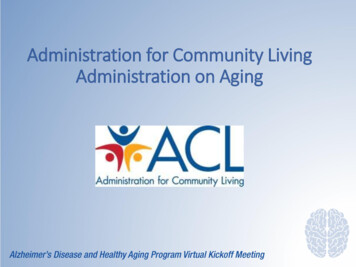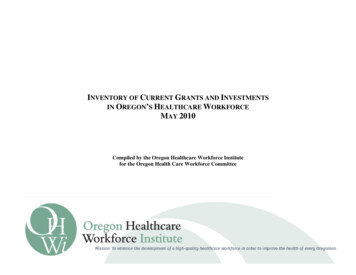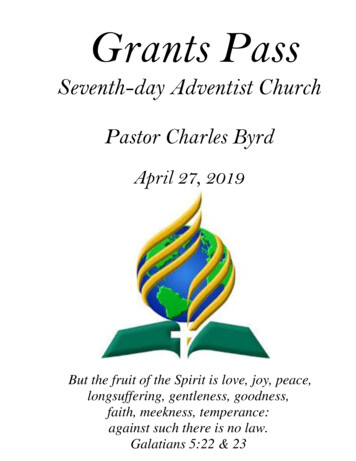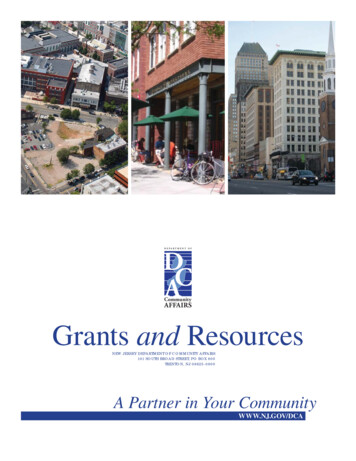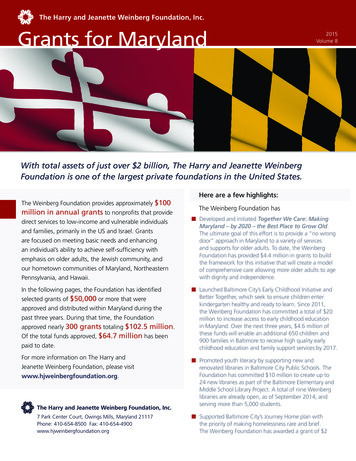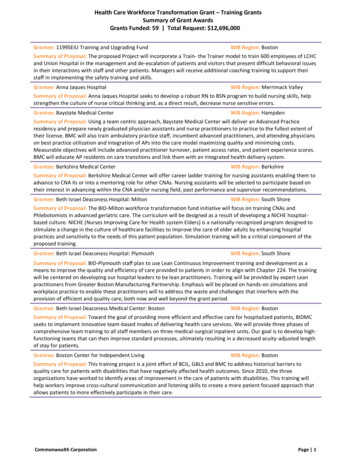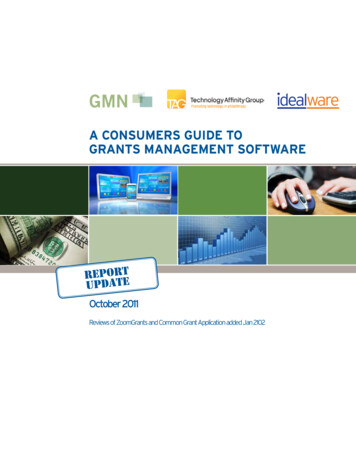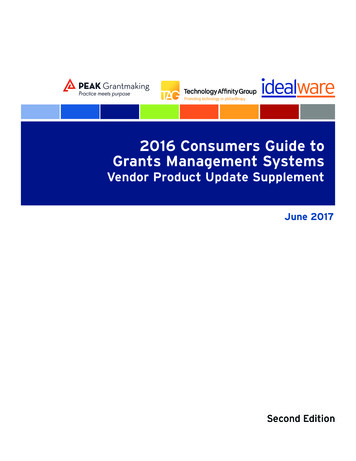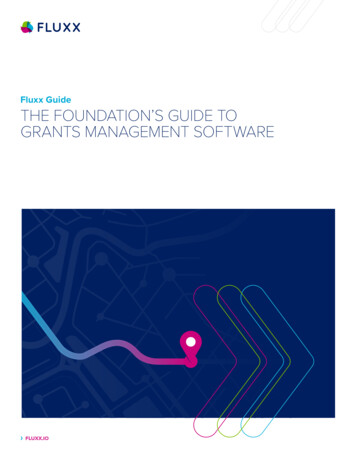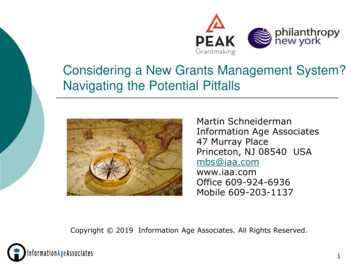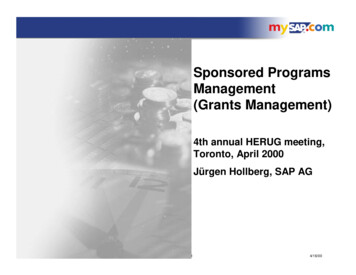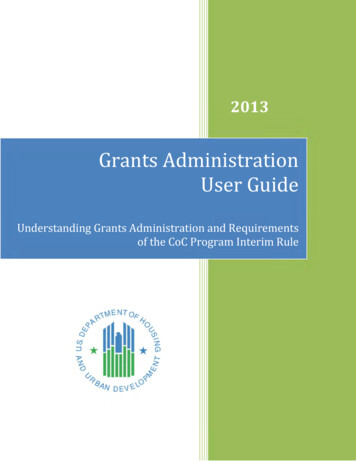
Transcription
2013Grants AdministrationUser GuideUnderstanding Grants Administration and Requirementsof the CoC Program Interim RuleGrants Administration User GuidePage iDRAFT: 10/11/2012
TABLE OF CONTENTS1. The Continuum of Care (CoC) Program . 11.1 Overview of CoC Program User Guide Series . 11.2 Citations within the Guides . 22. CoC Program Grant Award Process . 32.1 Requirements and Conditions . 32.2 Grant Agreement Execution . 32.3 Required Recipient Agreement. 42.4 Site Control . 62.5 Environmental Review . 73. Recordkeeping Requirements . 73.1 CoC-level Recordkeeping Requirements . 73.2 Recipient Organizational Recordkeeping Requirements . 83.3 Recipient Grant-Specific Recordkeeping Requirements . 93.4 Grant-Specific Program Participant Recordkeeping Requirements .103.5 Confidentiality of Records .123.6 Period of Record Retention .123.7 Access to Records .133.8 Reports .134. Grant and Project Changes .134.1 Significant Grant Amendments .134.2 Minor Changes .145. Performance Reviews and Sanctions .155.1 Performance Reviews .155.2 Remedial Actions and Sanctions .165.3 Deobligation of Funds .176. Closeout.17Grants Administration User GuidePage iFinal
1. THE CONTINUUM OF CARE (COC) PROGRAMThe Homeless Emergency Assistance and Rapid Transition to Housing Act of 2009 (HEARTHAct) amended the McKinney-Vento Homeless Assistance Act. Among other changes, theHEARTH Act consolidated three separate McKinney-Vento homeless assistance programs(Supportive Housing Program, Shelter Plus Care Program, and Section 8 ModerateRehabilitation SRO program) into a single grant program known as the Continuum of Care(CoC) Program. HUD published the Continuum of Care Program interim rule in the FederalRegister on July 31, 2012. The regulation took effect on August 30, 2012, and now governs theCoC Program.The CoC Program is designed to assist individuals and families experiencing homelessness andto provide the services needed to help such individuals move into transitional and permanenthousing, with the goal of long-term stability. More broadly, the program is designed to promotecommunity-wide planning and strategic use of resources to address homelessness; improvecoordination and integration with mainstream resources and other efforts targeted to peopleexperiencing homelessness; improve data collection and performance measurement; and alloweach community to tailor its project(s) to the particular strengths and challenges within thatcommunity.Each year, HUD awards CoC Program funds competitively to nonprofit organizations, States,units of local governments, and/or instrumentalities of State or local government, collectivelyknown as recipients. In turn, recipients may contract or subgrant with other organizations orgovernment entities, known as subrecipients, to carry out a grant’s day-to-day projectoperations.1.1 Overview of CoC Program User Guide SeriesA series of user guides has been developed to help CoCs, recipients, and subrecipientsadminister CoC Program funds (see box on next page). Recipients and subrecipients are theprimary audience for the user guide series.All user guides will be accessible on the OneCPD Resource Exchange.This user guide reviews the standards for administering CoC Program grants, with a specificfocus on the grant award requirements in Subpart C and the grant administration requirementsin Subpart G of the CoC Program interim rule.Grants Administration User GuidePage 1Final
Overview of Current and Forthcoming CoC User Guide SeriesEstablishing and Operating a CoC: This user guide outlines how to create an effective andrepresentative Continuum of Care in order to fulfill the roles and responsibilities set out in the CoCProgram interim rule.Introduction to Unified Funding Agencies (UFA): This user guide discusses the process forbecoming a UFA and the roles and responsibilities that accompany it.Determining and Documenting Homeless and At Risk Status, Income, and Disability: Thisuser guide discusses the criteria used to define homelessness and at risk of homelessness,including income, disability, and associated recordkeeping requirements.CoC Program Components and Eligible Costs: This user guide reviews the five CoC programcomponents and the costs that recipients and subrecipients may incur in administering andoperating CoC projects.CoC Program Funding for Homeless Management Information System (HMIS): This userguide reviews the role of the HMIS within the CoC and the differences between eligible HMIScosts incurred by recipients as part of a project and eligible costs incurred by the HMIS lead inestablishing, operating, and overseeing the use of the CoC's HMIS.Project Administration and General Program Requirements: This user guide describes projectadministrative costs and general program requirements applicable to the CoC Program—regardless of which components are carried out—such as match, calculating rents and occupancycharges, timeliness standards, and terminations.1.2 Citations within the GuidesThis guide references provisions of the McKinney-Vento Homeless Assistance Act and theCode of Federal Regulations (CFR). You may locate the relevant areas in the Act ramInterimRule.pdfTo locate a specific regulation, visit ecfr.gpo.gov/, select Title 24 for the HUD regulations, andselect the part number.Grants Administration User GuidePage 2Final
2. COC PROGRAM GRANT AWARD PROCESSThe CoC Program interim rule delineates responsibilities of CoC Program grant recipientsrelated to effective grant administration. Some of the activities related to administering the grantbegin at the time of grant award, prior to receiving an executed grant agreement.2.1 Requirements and ConditionsApplicants must satisfy all conditions before the execution of a grant agreement. Specifically, inorder to receive CoC Program funding, each applicant must meet all requirements and provideproof of satisfying those requirements. These requirements include: site control; matching funds; environmental review requirements; and documentation of financial feasibility.Applicants must satisfy these requirements within 12 months of the announcement of award, orwithin 24 months in cases where applicants receive funds for acquisition, rehabilitation, or newconstruction. HUD may extend the 12-month deadline if the applicant can provide compellingreasons for delay due to factors beyond its control.In addition to these standard conditions required of each applicant before grant execution, HUDmay also impose conditions on all or parts of the application. Examples of these conditionsinclude requests for supporting documentation on a project, revisions to the project budget, ormodifications to a proposed activity to ensure compliance with the regulations.HUD will withdraw an award if the applicant does not satisfy all conditions.2.2 Grant Agreement ExecutionThe grant agreement establishes the rights and responsibilities of HUD and the recipient. Therecipient is responsible for ensuringthat the grant agreement is executedUnified Funding Agency (UFA)with HUD and that the terms of theAUFAisatypeof collaborative applicant selected by aagreement are carried out. TheCoC and approved by HUD to apply for funding for allrecipient and HUD must execute theprojects in the CoC’s geographic area; to sign agreementsgrant agreement no later than 45and distribute funds to subrecipients; to oversee the fiscaldays from the date on which allcontrols for subrecipients; and to obtain approval for anyconditions are satisfied (24 CFR partgrant amendments.578.23). If a CoC designates more thanone applicant for its geographic area, HUD will enter into a grant agreement with eachapplicant awarded funds. If a CoC designates only one applicant for the geographic area, HUD may enter into a grantagreement with that applicant for new awards, if any, and into another grant agreement forrenewals, CoC planning, and Unified Funding Agency (UFA) costs, if any. The two grantswill cover the entire geographic area.Grants Administration User GuidePage 3Final
If the collaborative applicant is a HUD approved UFA, then HUD may enter into one grantagreement with the UFA for new awards, in addition to one grant agreement for renewals,CoC planning, and UFA costs, if any. These two grants will cover the entire geographicarea.2.3 Required Recipient AgreementBefore the release of grant funds from HUD, recipients must ensure that they are able to carryout the terms and conditions described in the grant agreement, including any requirements fromadditional federal regulation(s), as applicable. As stated above, HUD will require grant recipientsto sign a grant agreement in which they agree to specific terms, including the provision ofoversight of projects, subrecipients, and any contractors. These terms, listed in 24 CFR part578.23, are summarized below.Compliance with the CoC Program Interim RuleThe recipient must operate the project within provisions of the CoC Program interim rule andall related regulations. In addition, the recipient must agree to monitor and report projectprogress to the CoC and HUD. The recipient must also comply with any additional terms andconditions specified in the applicable CoC Program Notice of Funding Availability (NOFA).Adequate Fiscal Control and Accounting ProceduresIf the recipient is a UFA, it must establish adequate fiscal control and accounting proceduresto ensure the proper disbursal of, and accounting for, CoC Program grant funds, and that allfinancial transactions are conducted and that records are maintained in accordance withgenerally accepted accounting principles.Subrecipient Agreements, Compliance, and MonitoringCertificationsThe recipient must obtain certifications from subrecipients with respect to: Confidentiality of records, specifically for those records pertaining to any individual orfamily that was provided family violence prevention or treatment services through theproject; Confidentiality of the locations of family violence projects; Establishment of policies and practices that enable program participants to exercisethe rights afforded them under subtitle B of title VII of the Act and other laws relatingto the provision of educational and related services to individuals and familiesexperiencing homelessness; Designation of staff in family projects to ensure that children of program participantsare enrolled in school and connected to early childhood programs and otherappropriate services; Status of recipient and partners regarding debarment or suspension of business withthe federal government; and Agreement to provide information, such as data and reports, as required by HUD.Grants Administration User GuidePage 4Final
AgreementsThe recipient must enter into subrecipient agreements requiring subrecipients to operateprojects in accordance with the provisions of the CoC Program interim rule. Agreementsmust also specify requirements delegated from the recipient to the subrecipient andrecordkeeping that must be maintained to support subrecipient monitoring.MatchThe recipient must verify that subrecipients have the required match commitments priorto grant execution and verification of match expended or providedin-kind to the project.MonitoringThe recipient must monitor subrecipients and projects at least annually. Recipientsshould have open access to all grant-related information, including program participantand financial records. The specific requirements of subrecipient monitoring arediscussed further in Section 5 of this user guide.Homeless Consumer InvolvementProjects should involve homeless individuals and families in as many aspects of projectimplementation as practical, including employment, provision of volunteer services, orotherwise, in constructing, rehabilitating, maintaining, and operating facilities for theproject and providing supportive services for the project.Educational Needs of ChildrenIn addition to the subrecipient certifications regarding supporting the educational anddevelopmental needs of children of program participants, recipients must take theeducational needs of children into account when families are placed in emergency ortransitional shelter (24 CFR part 578.23(c)(7)). Recipients should, to the extentpracticable, place families with children as close as practical to their school of origin soas not to disrupt the children's education. Any barriers should be documented in both theprogram participant and project files.Written StandardsRecipients and subrecipients must follow the written standards developed by the CoC forproviding assistance (24 CFR part 578.7(a)(9)) and comply with standards in the CoCProgram interim rule. For more information, see the User Guide on Establishing andOperating a CoC.Coordinated Assessment SystemRecipients must use the coordinated assessment system established by the CoC, inaccordance with CFR part 578.7(a)(8). For more information, see the OneCPDResource Exchange.Grants Administration User GuidePage 5Final
2.4 Site ControlSite control establishes evidence that project sites are secured and that recipients orsubrecipients are able to operate in given locations. Acceptable evidence of site control is adeed or lease. If CoC Program funds are to be used for acquisition, a purchase agreement isacceptable evidence of site control. The owner’s, lessee’s, or purchaser’s name/organization onthe deed, lease, or purchase agreement must be the applicant or intended subrecipientidentified in the original application for CoC Program funds.Site control must be obtained within 12 to 24 months of announcement of the awarded funds. For projects with operating and/or supportive services funding, site control must becompleted within 12 months of announcement of the award. For projects with acquisition, new construction, and/or rehabilitation funding, site controlmust be completed within 24 months of announcement of the award.The above requirements do not apply to: Housing that will be eventually owned or controlled by individuals or families served; and Supportive services provided in buildings that are not owned or operated by the recipient orsubrecipient.Recipients or subrecipients may obtain ownership or control of a suitable site different from thesite specified in the application.Site Control and Tax Credit PropertiesProject applicants that plan to use low-income housing tax credits (LIHTC) to finance aproject that also uses CoC Program funds must demonstrate to HUD that the applicant orsubrecipient is in control of the limited partnership or the limited liability corporation that hasa deed or lease for the project. To demonstrate control of the limited partnership, the applicant or subrecipient must bethe general partner or have a 51 percent controlling interest in the general partner. To demonstrate control of the limited liability corporation, the applicant or subrecipientmust be the sole managing member.If CoC Program funds will be used for acquisition, new construction, or rehabilitation in aLIHTC project, the recipient or subrecipient must maintain control of the partnership orcorporation and own the project site for 15 years. The 15-year period starts from the date ofinitial occupancy of the housing or initial provision of services. During that time, the recipientor subrecipient must ensure that the project is operated in compliance with all applicablelaws and regulations.If CoC Program funds are not used for acquisition, new construction, or rehabilitation in aLIHTC project, the recipient or subrecipient must maintain control for term of the grantagreement and any subsequent renewals.Grants Administration User GuidePage 6Final
2.5 Environmental ReviewProjects assisted with CoC Program funds are subject to environmental review by HUD under24 CFR part 58. Recipients or subrecipients must provide all available, relevant informationrequired for an environmental review in order for HUD to authorize the release of funds for eachproperty. Before proceeding with grant implementation, the recipient or subrecipient mustsubmit documentation supporting the successful completion of an environmental review. HUDmust approve the environmental certification and Request for Release of Funds (RROF).No activities may be performed on a project site until the Responsible Entity (RE) hascompleted the environmental review and HUD has authorized release of funds for the property.Specifically, the recipient or subrecipient, its project partners, and their contractors may notacquire, rehabilitate, convert, lease, repay, dispose of, demolish, or construct property for aproject or commit or expend HUD or local funds for these activities until HUD has authorized therelease of funds. If environmental issues are found, the recipient or subrecipient must carry outany mitigating measures required by HUD or select an alternative eligible property.HUD will not release grant funds if the recipient or any other party commits grant funds(i.e., incurs any costs or expenditures to be paid or reimbursed) before the recipient submits andHUD approves its RROF.3. RECORDKEEPING REQUIREMENTSRecipients and subrecipients are required to: Establish and maintain standard operating procedures to make sure that program funds areused in accordance with regulatory and CoC Program NOFA requirements; and Maintain sufficient records to enable HUD to determine whether recipients and subrecipientsare adhering to regulatory requirements.3.1 CoC-level Recordkeeping RequirementsThe CoC and its collaborative applicant must maintain records documenting compliance withthe CoC Program interim rule requirements related to establishing and operating the CoC.Additional recordkeepi
The recipient must monitor subrecipients and projects at least annually. Recipients should have open access to all grant-related information, including program participant and financial records. The specific requirements of subrecipient monitoring are discussed
